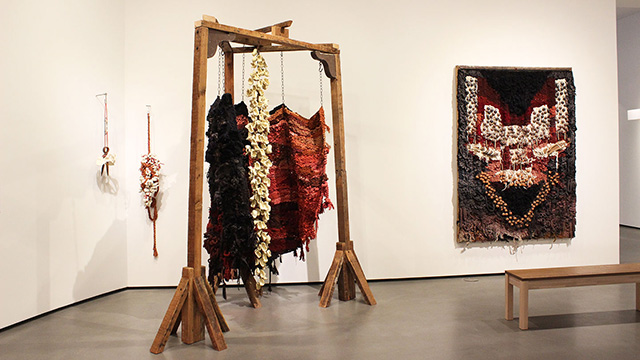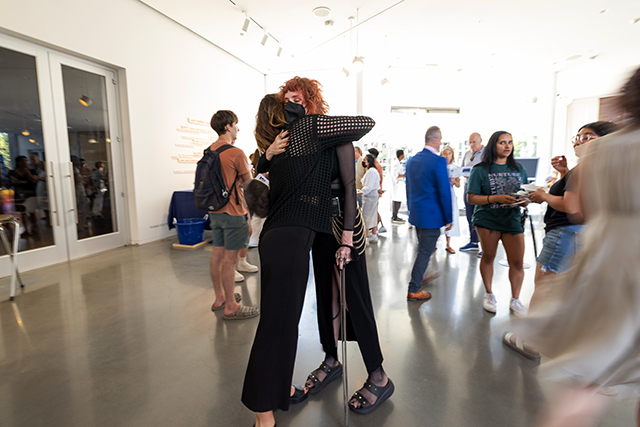
April Camlin equates making art to the grieving process: both are complex, nuanced and full of mixed emotions that change with the days. By working with organic materials, Camlin reflects the impermanence of life itself.
“I work with materials that are not going to last forever and that are going to change over time and that have a life cycle and that will die, and that feels to me authentically human,” the recent M.F.A. in art studio graduate said.
A mixed media textile artist and musician, Camlin brings her experience of grief, pleasure and pain into her work. She also focuses on the healing powers of expression and community. Instead of seeing a disconnect between concepts like life and death, Camlin sees them as interwoven, existing both in spite of and because of the other.
“I think that’s the beautiful thing about humans is that we can hold seemingly contradictory ideas at once, that we can contain multiple truths simultaneously — that I can be in a state of abject grief and joy and ecstasy and gratitude at the same time," she said.
Transforming the material and the immaterial
This past spring, Camlin took a top prize at the Arts & Humanities 2024 Graduate Exhibition. Her piece, It’s Coming Back won the 2024 LeShelle & Gary May Art Purchase Prize, which means it has a forever home in the university’s Fine Arts Collection.
It’s Coming Back is made of hand-twisted rope, ceramics, theraband tubing, used hardware and an anatomical model. The work is in two parts, one of which resembles reproductive organs, the other a mass of bone-like structures clustered together bound by red tubing and rope.

"This work was created to cope with the resurgence of limitations to my mobility which ebb and flow like the tide," Camlin said. She formed the many ceramic vertebrae from bed while recuperating from a surgical procedure. "Not truly anatomically correct, creating them became a meditation on the differences we all hold within our bodies."
"To me, the most important thing about these vertebrae is that no two are the same. This expresses a major theme of my work: the yearning for our differences, divergences, and non-conformities to be seen and respected," Camlin explained. "The vertebrae were bound together using theraband, a material that anyone who's gone through some physical therapy will be well-acquainted with. For the most part, chronic pain is an invisible illness on the outside, but on the inside, it inhabits and informs my entire reality, and this work was an attempt to make something invisible into something that can be seen and shared."
Some of Camlin’s favorite materials to work with are ones with textures that she likes feeling in her hands, silks and velvety ropes and beads. She works mostly with salvaged materials, calling herself a “scavenger.” Her tapestries featured in the Graduate Exhibition were made from found objects, salvaged lumber, hand-twisted rope, eucalyptus bark, ceramics, beeswax and iron oxide.
“I grew up poor and have always been resourceful in how I make my work and obtain my materials,” Camlin said. “I have to do a lot of processing and transforming and finding things and turning them into something else — that's happening a lot.”
Finding community and support at UC Davis
At first wait-listed, Camlin knew it wasn’t a matter of “if” she would be admitted into the M.F.A. in the Maria Manetti Shrem Art Studio Program at UC Davis, it was a matter of “when.”
“I really believe things happen in their right time,” she said.
Camlin left her established studio practice in Maryland, where she grew up, and joined the graduate program in 2022.

“I felt I had gone as far as I could go there and really was ready to challenge myself and to be challenged in a supportive community,” she said. “I really had a good feeling about the level of authenticity that was expected and encouraged and that it wasn’t a program that was just about creating commercial artists, it was about connecting you to your practice in a deeper and clearer, more focused way.”
Camlin overcame exceptional odds while studying in California, pushing herself to the edges of her work even while dealing with significant health issues. She credits her mentors at the College of Letters & Science at UC Davis for helping her leave her comfort zone. It has made her work riskier and more vulnerable but also more thrilling.
“I had to be willing to work in ways that were unfamiliar to me and not know where I was going and, I think, that used to feel really scary and disorienting. Now it feels exciting,” she said. “That’s where the magic is.”
Camlin is the recipient of the graduate fellowship at the Headlands Center for the Arts in Sausalito, Calif. She’ll have studio space there for the next year and will also be hosting weaving workshops for sexual assault survivors.
